Screening and Characterization of Nitrite-Degrading Bacterial Isolates Using a Novel Culture Medium
MA Qingshan, and HE Zengguo, 2),
Screening and Characterization of Nitrite-Degrading Bacterial Isolates Using a Novel Culture Medium
MA Qingshan1), and HE Zengguo1), 2),*
1)School of Medicine and Pharmacy, Ocean University of China, Qingdao 266003, China 2) Marine Biomedical Research Institute of Qingdao, Qingdao 266003, China
In this study, a novel culture medium that simulates shrimp pond conditions was established to screen nitrite-degrading isolates. The medium was supplemented with nitrite as a nitrogen source and shrimp feed as the major carbon source, to achieve the high nitrogen and low carbon nutritional status found in shrimp farming ponds. Screening using this medium identified potent denitrifyingisolates, among whichM7-1 was considered best. M7-1 was able to completely degrade nitrite-N in 24h without much consumption of dissolved oxygen. Efficient denitrification activity took place in liquid cultures within a set of non-stringent ranges of pH (5.0–9.0), salinity (0–30) and temperature (25–35℃). The denitrifying enzyme gene was amplified, sequenced and further identified astype. In biosecurity assessments, M7-1 had no negative effects on shrimps at a dose of 106cfu mL?1. M7-1 could therefore be used in aquaculture to reduce and control the nitrogen concentration, and to promote the development of sustainable and healthy culture systems.
aerobic denitrification; nitrite; screening culture medium;
1 Introduction
With the rapid development of aquaculture farming In- dustries, high density farming techniques are now widely adopted in China, facilitated by a raft of approaches including oxygenation enhancement, intensive feeding and the frequent addition of antibiotics for disease control (Liu., 2017). Such intensive industrialized farming methods have improved yields from aquatic farming of animals, as repeatedly noted, they may also lead to the buildup of unused feed, excreta and other biological residues, as well as the accumulation of harmful chemicals such as nitrite.
It is well known that high concentrations of nitrogen lead to formation of nitrite, which is highly toxic in aqua- culture environments (Miron., 2008). The frequently documented pernicious effects of nitrite include direct toxicity to fish and other aquatic organisms (?iljeg., 2010; Medeiros., 2016), induction of a variety of physiological disorders, immune suppression (Tseng and Chen, 2004), and mutagenic and carcinogenic potency (Hotchkiss., 1992). Some reports have indicated that fish disease outbreaks co-occur with the presence of high levels of nitrite (Cheng and Chen, 1999). Hence, it is of critical importance to establish practical methods for nitrogen removal and control.
In practice, both physicochemical methods and biolo- gical approaches are attempted to deal with nitrite (To- masso, 1994). The former methods are now less favored because of the associated secondary pollution caused by their use and side-effects on fish and other living organisms (Hui., 2018). By contrast, biological appro- aches to nitrite degradation using live microbial preparations have been shown to be reliable, economical, and efficient means of nitrite control (Sun., 2016; Huang., 2017; Wan., 2017). At present, about 130 species of bacteria in 50 genera have been reported to have potential denitrification capability (Holt, 1994; Ji.,2015). Denitrification is usually performed in an anoxic environment by anaerobic autotrophic denitrifying bacteria, which typically propagate slowly and are difficult to cultivate under the aerobic conditions present in farm pond environments (Li., 2005). Interest in aerobic denitrifying bacteria has been increasing recently, particularly focusing on species ofand(Ma., 2005; Song., 2011; Huang,., 2017). Under farm conditions, denitrification by aerobic bacteria is much more efficient than autotrophic denitrification by anoxic bacteria because of the faster growth rates of aerobic bacteria facilitated by their heterotrophy (Khin and Annachhatre, 2004; Third., 2005).
probiotics, such asandhave been widely used in aquaculture to improve water quality (Lalloo., 2007; Nimrat., 2012; Arig., 2013; Zokaeifar., 2014). The spore-forming properties ofspp. make them sui- table for formulation as economic yet effective microbial preparations for large scale production and applications.
The majority of the known methods for screen denitrifyingspp. are based primarily on the capability of the target candidates to degrade nitrite in selected nitrite-containing media. These specific chemically defined denitrification media (termed SCDDMs hereafter) all include nitrite as the sole nitrogen source, and either glucose, sucrose, sodium citrate, sodium succinate or acetate as carbon sources (Ren., 2014; Zokaeifar., 2014; Duan., 2015; Gui., 2017; Huang., 2017; Sun., 2017). However, the carbon-rich feature of SCDDM is rarely found in real pond environments, which tend to be low in carbon and high in nitrogen nutrients. Furthermore, screening is frequently conducted in the absence of shrimps, aeration and intensive feeding conditions. In this report, a novel medium to screen nitrite degrading isolates was established by applying laboratory conditions simulating the shrimp pond environment. The medium was aerated using a rotary shaker, and contained nutrients similar to those found in shrimp-pond water. It was supplemented with NaNO2at 0.05gL?1and shrimp feed at 1gL?1. This medium is referred to Pond-Simulating Denitrification Screening Medium (PSDSM). A range of potentisolates was screened using the aforementioned methods, and M7-1 was demonstrated to be the most suitable strain. The gene responsible for denitrification was analyzed, and the safety and factors affecting denitrification were evaluated.
2 Materials and Methods
2.1 Samples and Culture Media
One hundred and twenty-four samples were collected into sterile conical flasks and stored at 4℃ until isolation of denitrification bacteria from water and soils in fish and shrimp ponds in Tianjin, Fujian, Guangdong and Jiangsu Provinces, China.
The culture media were as follows: Luria-Bertani (Me- deiros., 2016) liquid medium: tryptone 10g, yeast extract 5g, NaCl 10g, distilled water 1000mL, pH 7.0 (1.5%-2.0% agar was added for solid medium, the same below). SCDDM: sodium succinate 4.72g, NaNO20.05g, KH2PO41g, FeSO4·7H2O 0.05g, CaCl20.2g, MgSO4·7H2O 1g, distilled water 1000mL. PSDSM: shrimp feed 1g, NaNO20.05g, distilled water 1000mL. The composition of shrimp feed (Charoen Pokphand Group, Thailand): imported fish meal, soybean meal, peanut bran, squid powder, high gluten flour, nutrient content as follow (Table 1).

Table 1 The composition of shrimp feed
Note: TP, total phosphorus.
2.2 Isolation of Bacillus Strain
One g of sample dilutions were placed into 18mL tubes containing 9mL of sterile LB liquid medium and the mixed broth was heated in 85℃in water bath for 10min. The broth were then incubated at 30℃ for 16h in rotary shaker (Peiying, Jiangsu, China) at 180 rotations per minute (rmin?1) to allow the spores germinate. Gradient dilution of above broth was carried out by multiple proportion dilution method, followed by plating on LB solid plates, and then being cultured at 30℃ for 20h in constant temperature incubator. 275 strains were isolated and purified for further assay.
2.3 Hemolytic Assays of Isolated Strains
Isolates were subjected to safety evaluation using the hemolytic assays (Bernheimer, 1988). Each single colony was placed on the blood agar plate (Merck, Germany) and incubated at 30℃ for 24h, 48h and 72h for hemolysis observation. After hemolysis test 63 out of 275 isolates were streaked on a PSDSM solid medium. The emerginglike colonies were picked out and cultivated in LB liquid medium (30℃, 16 h) for denitrification assay.
2.4 Screening of Aerobic Denitrifying Bacillus
The selected bacterial strains culture were inoculated into 250mL sterilized conical flasks containing the PSDSM with final concentration adjusted to 5×105cfumL?1individually with three repetitions. After 48 h of incubation at 30℃ in the shaker (180 rmin?1) for aerobic culture, the samples were homogenized into 1.5mL centrifuge tubes and centrifuged at 12000rmin?1for 3min for nitrite nitrogen (nitrite-N) measurement. The concentration of nitrite-N of media supernatant was determined using N-(1-Naphthyl)-ethylenediamine photometric method (GB, 1987). The formula of degradation rate of nitrite-N was as follows:
Nitrite-N degradation rate (%)= (end–original)/original×100% ,
end-Nitrite-N concentration at the end of the culture,
original-Nitrite-N concentration before the culture.
2.5 Assessment of the Nitrite-N Degradation Rate (Static Culture) of Strain M7-1
Aliquots of the strain M7-1 culture broth were inoculated into 250mL sterilized conical flasks containing PSDSM at a final concentration of 5×105cfumL?1with three repetitions individually. After static liquid culture at 4, 8, 12, 16, 20 and 24h, the broth was measured the concentrations of nitrite-N. The DO was determined by the Portable hand-held dissolved oxygen meter-S975 SevenExcellenceTM(METTLER TOLEDO, Zurich, Swi- tzerland).
2.6 Effects of Different Factors on Nitrite-N Degradation Rate of Strain M7-1
The degradation rate of nitrite-N was determined at different levels of factors such as temperature, pH, and salinity, respectively. The activated strain M7-1 was inoculated into 250mL of SPDSM broth, with cell density adjusted at 5×105cfumL?1and cultured for 48h in the shakers (180rmin?1) at tested temperatures with three re- petitions individually. The broth was centrifuged at 12000 rpm for 3 min, followed by taking 200μL supernatant to measure the concentrations of nitrite-N. Designed test conditions set for cultivation as follows: temperature at 10, 15, 20, 25, 30, 35 and 40℃; pH at 3, 5, 7, 9 and 11; the salinity at 0, 5, 10, 15, 20, 25 and 30, respectively.
2.7 Identification of Strain M7-1
Initial identification schemes were performed with bio- chemical tests as suggested by the Bergey’s manual of determinative bacteriology (Holt, 2001). The molecular taxonomy of the isolates was determined by 16S rRNA sequencing. The total DNA was extracted by using DNA extraction kit (Sangon Biotech, Shanghai, China). Amplification of the 16S rRNA gene fragments (V3V4 region) was done by polymerase chain reaction (PCR) using bacterial universal primers 27F (5’-AGAGTTTGATCCTG GCTCAG-3’) and 1492R (5’-GGTTACCTTGTTACGA CTT-3’) and sequenced by Shanghai Sangon Biotech Co., Ltd. (Shanghai, China). The partial 16S rRNA gene sequence was compared with other bacterial sequence data using the Basic Local Alignment Search Tool (BLAST). A phylogenetic tree of strain M7-1 was constructed based on the comparison of sequences with other reference bacteria sequences using neighbor-joining (NJ) analysis with 1000 bootstrap replicates (Molecular Evolutionary Genetics Analysis, MEGA 7.0 version).
2.8 Amplification of the Nitrite Reductase Gene Sequence
Fragments of theandgene of M7-1 were amplified using primer pairs1F-5R forand1F-6R foraccording to the method of Braker. (1998). The primers pairs were
1F: 5’-GG (A/C)ATGGT (G/T)CC(C/G)TGGCA- 3’,
5R: 5’-GCCTCGATCAG (A/G)TT (A/G)TGG-3’,
1F: 5’-CCTA(C/T)TGGCCGCC(A/G)CA(A/G)T- 3’,
6R: 5’-CGTTGAACTT (A/G)CCGGT-3’.
PCR reaction mixtures contained 2×PCR mix 30μL (TaKaRa, Dalian, China), 2.5μL of each specific primer (Sangon Biotech, Shanghai, China), M7-1 gene templates 2.5μL and ddH2O 22.5μL. The condition of PCR reaction was set as: 95℃ for 5s, 95℃ for 30s, 58℃ for 30s, 72℃ for 60s, 30cycles, and then extension at 72℃ for 10s. After verification by electrophoresis on a 1.0% agarose- gel, the PCR products were sent to Sangon Biotech- Shanghai China (Shanghai, China) for sequencing. The sequence obtained was compared with those of other microorganisms in GenBank by using BLAST.
2.9 Assessing the Biosecurity of Strain M7-1 for Shrimp
To test the safety of strain M7-1, an indoor tank (28 cm×18cm×17cm) system was applied. In experiments, shrimps) were obtained from CP GROUP (Hainan, China). The healthy shrimps (1.5±1.0 cm) were pre-incubated in tanks containing aerated sea water (salinity 20, pH7.2) at 26℃ for 1 week for adaption. Then the shrimps (10 per tank) were challenged with different concentrations of M7-1 for 96h. During the incubation, half of the tank water in each tank was replaced with fresh and filtrated sea water daily and shrimps were fed with the commercial pellet feed (Charoen Pokphand Group, Thailand) daily. Shrimp vitality was checked periodically at 24, 48, 72 and 96h, respectively. For safety assay the M7-1 challenged test tanks were arranged as follows: 1) control, non M7-1; 2) 104, M7-1 concentration at 104cfumL?1; 3) 106, M7-1 concentration at 106cfumL?1. Each test was performed in triplicate, and the mortality rates were measured at the end of cultivation.
Mortality rate was calculated using the following equations:
Mortality rate (%)= (Initial shrimp count-final shrimp count)/initial shrimp count×100% .
3 Statistical Analyses
All data were analyzed by one-way ANOVA using Statistical Analysis Systems (SAS) statistical software package. Signi?cant difference was assessed at<0.05.
4 Results
4.1 Isolation of the Denitrifying Bacillus
In experiments, up to 275 of spore-forming bacteria isolates were obtained from samples, and then purified to pure culture and subjected to denitrification test. 63 out of 275 isolates were chosen for further denitrification test using PSDSM solid medium supplied with nitrite and shrimp feed stuff under aerobic conditions. Among them, 10 isolates were selected for nitrite-N degradation rate test, and isolate M7-1 was found to be the best, with nitrite-N degradation rate amounting to 99.70% in 24h (Figs.1, 2).
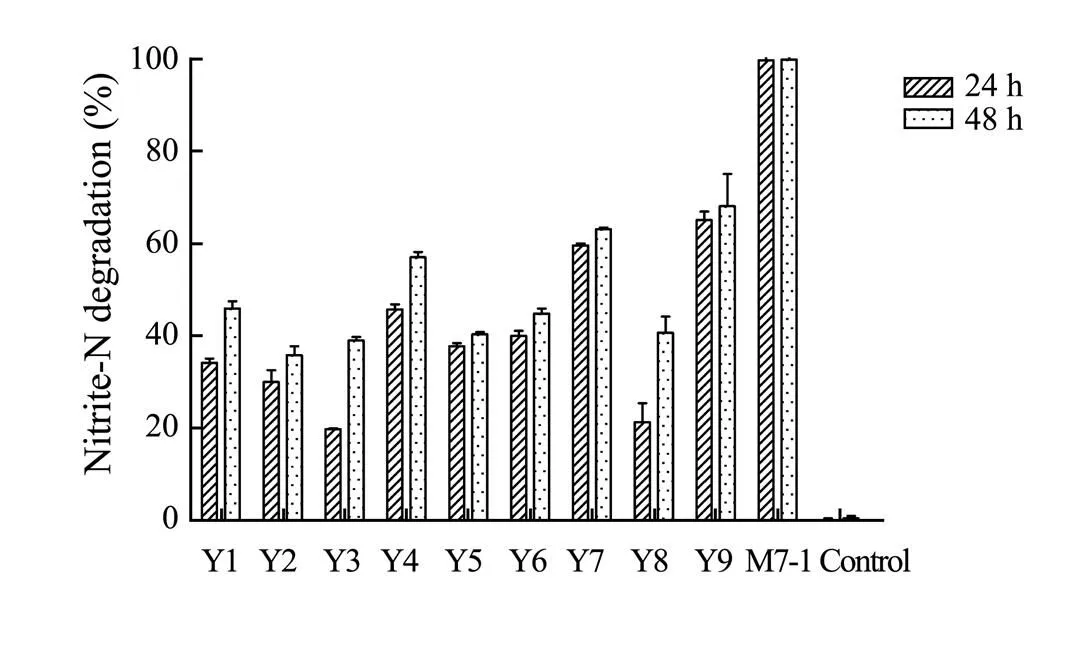
Fig.1 Determination of nitrite-N degradation rate of 10 selected strains. Values are expressed as the mean (n=3) and the error bars represents standard deviation (SD), the same below.
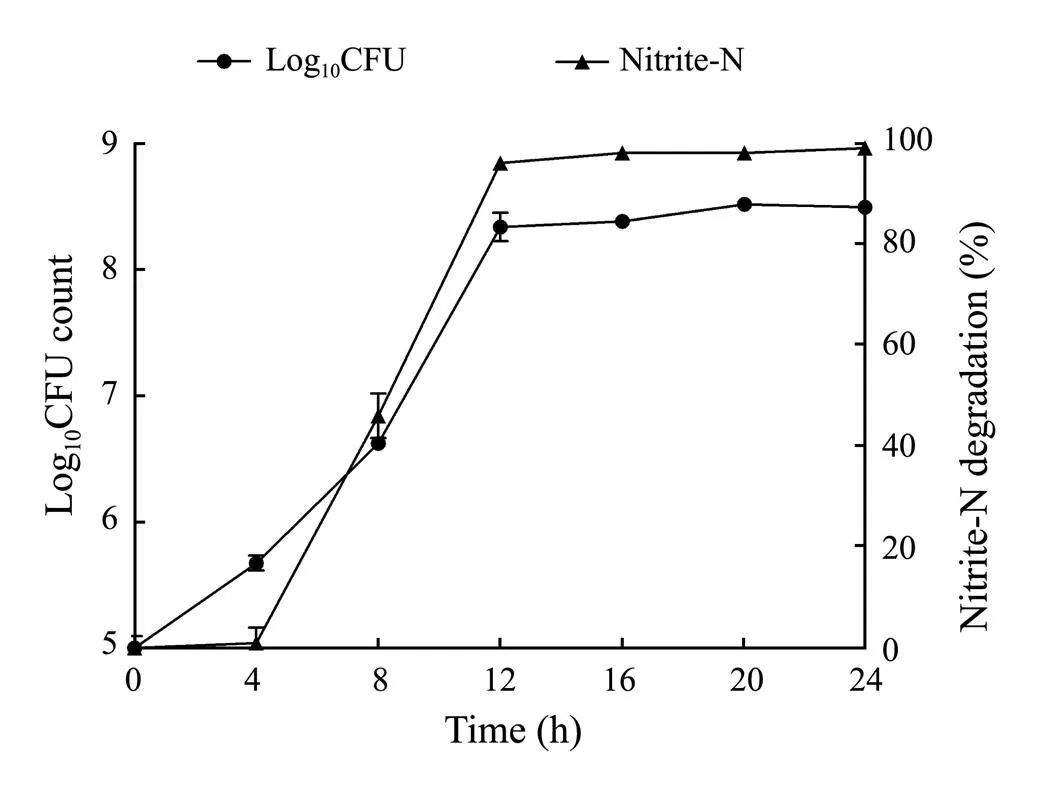
Fig.2 Dynamics of strain M7-1 growth and degradation curves of nitrite-N.
4.2 Nitrite-N Degradation Rate (Static Culture) of Strain M7-1
As shown in Fig.3, after 12h of static culture, the nitrite-N in the broth was removed to the most (up to 96%), with a slow DO declining tendency. Afterwards though DO kept dropping slightly, the denitrification kept going until NO2?was nearly completely eliminated, whereas DO in broth was still above 4.5mgL?1.
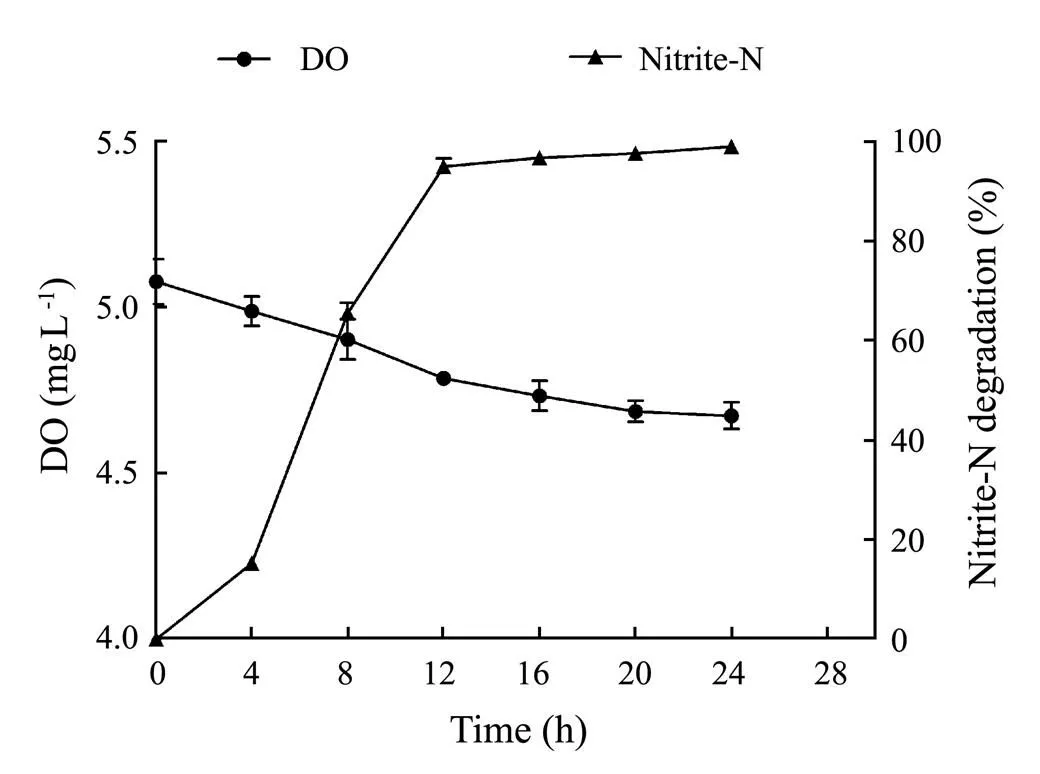
Fig.3 DO and degradation curves of nitrite-N.
4.3 Nitrite-N Degradation Rate of Strain M7-1 Under Different Culture Conditions
It was found that the nitrite-N degradation rate of M7-1 reached its peak at pH 7.0, when it was cultivated at a wide range of pH (Fig.4). It was also observed that at the temperature range from 10 to 37℃, nitrite-N degradation rate of M7-1 kept increasing, and it peaked at 30℃, with almost 100% removal; whereas the degradation slightly declined as temperature going higher (Fig.5). As exemplified in Fig.6, nitrite-N degradation rate of M7-1 did not change much when the water salinity increase from 0–20, it even could maintained at 87% as the salinity going higher until reaching 30.
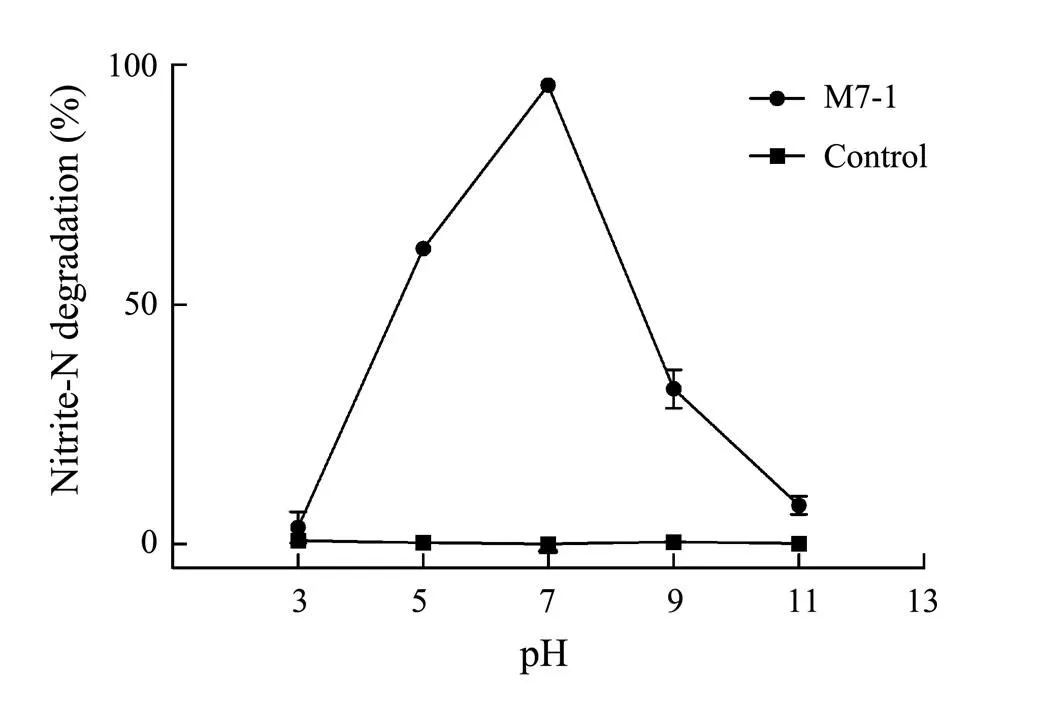
Fig.4 Degradation curves of nitrite-N under different pH values.
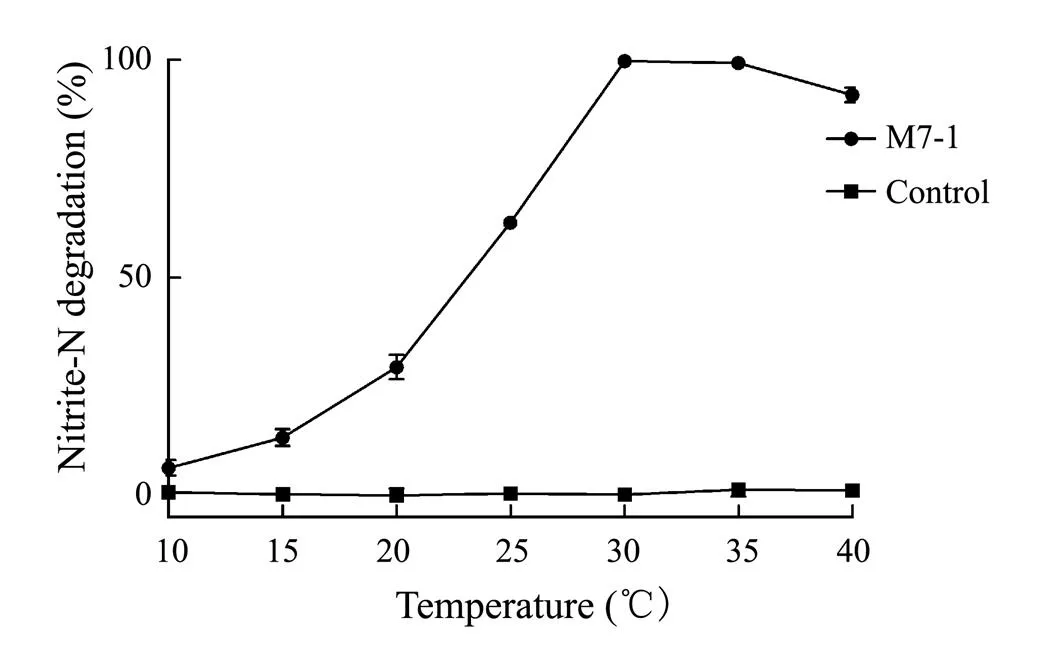
Fig.5 Degradation curves of nitrite-N under different water temperature .
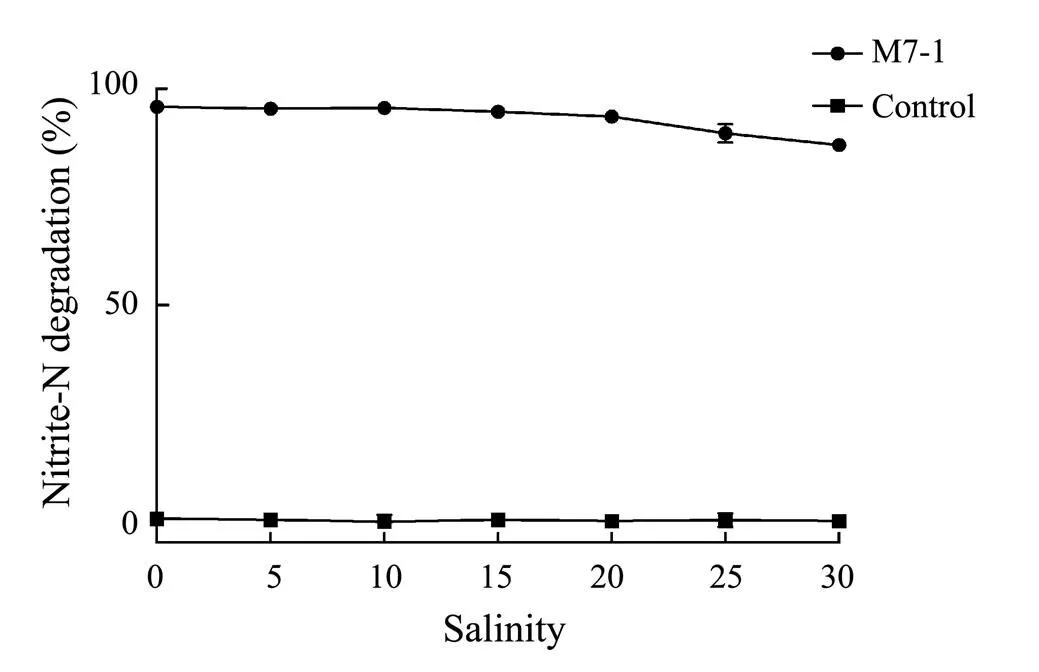
Fig.6 Degradation curves of nitrite-N under different salinity.
4.4 Identification of Strain M7-1
M7-1 showed the typical characteristics ofspecies, which were gram-positive, rod-shaped, measuring (0.8–1.2)×(1.5–4.0)μm, H2S test-positive, VP test- positive, indole test-negative, and containing spore-form- ing aerobic bacteria (Table 2). 16S rRNA identification revealed that the M7-1 strain was 99% homology genetic relationship with(Fig.7). Based on the above results, the strain M7-1 was identified as.
4.5 Amplification of Nitrite Reductase Sequence
Through analysis of the PCR products, onlywas amplified, with a band of about 800bp observed (Fig.8), whereas no sequence corresponding toamplified. NCBI homology blast results showed thatgene of M7-1 was homologous to that ofstrain FJ7 (GenBank accession No. JQ319506.1) by 60.84%.

Table 2 Morphological, physiological, and biochemical characterization of strain M7-1
Notes:*‘+’ and ‘?’ represent the positive and negative response, respectively.

Fig.7 Phylogenetic tree based on 16S rRNA gene sequence of Bacillus M7-1.
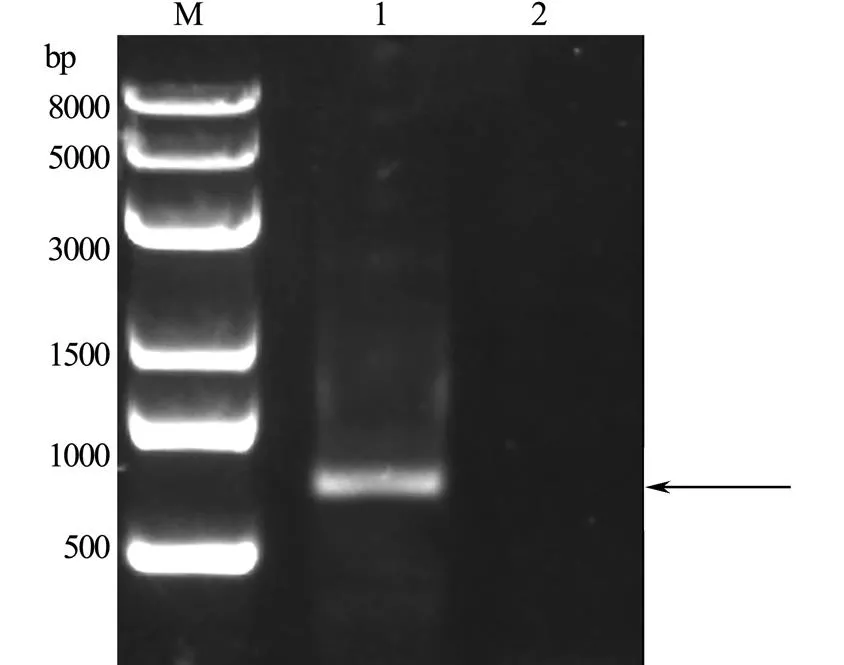
Fig.8 Amplification profiles of nirS and nirK from Bacillus M7-1.
4.6 Biosecurity of Strain M7-1
As showed in Fig.9, M7-1 presented negative results in the hemolytic assays, indicating it was safe for use. When the culture of M7-1 was added to shrimp sink, no shrimp death was observed in any test arrangements, which revealed that M7-1 was safe for aquaculture farming use (Table 3).

Table 3 The effect of strain M7-1 on mortality rate of shrimps

Fig.9 Hemolytic analysis of strain M7-1.
5 Discussion
In shrimp farm pond water, nitrogen exists in the form of molecular nitrogen (N2), inorganic nitrogen (NH4+, NH3, NO3?, NO2?), and organic nitrogen (.., urea, amino acids, proteins) (Crab., 2007). Under the influence of both biological and non-biological factors and farming manipulations, these forms of nitrogen are constantly being dynamically transformed, transported and circulated within the pond water (Hargreaves, 1998; Wongkiew., 2017). The persistence of high nitrite levels poses a severe threat to aquaculture industries, because of its toxicity, and carcinogenic and immune suppression effects (Jensen, 2003; Camargo and Alonso, 2006).
To date, the application of denitrifying bacteria is the most acceptable means of nitrite removal from farm ponds (Van Rijn., 2006; Zhou., 2011). There have been frequent reports of denitrifying bacteria that document their denitrification features under laboratory conditions using SCDDM (Song., 2011; Ren., 2014; Zokaeifar., 2014; Duan., 2015; Gui., 2017; Huang., 2017; Sun., 2017). However, the majority of the isolates described are not truly suitable for aquacultural farming practice because they merely show- ed denitrification effects under specific laboratory conditions, which were not comparable with those in farm pond environments (Pai., 1999). Probably, an important cause of such failures is associated with the reporting of ‘spurious’ denitrification capabilities of isolates that were only able to remove nitrite from broths with high C:N ratios,.., composed of chemically defined carbon sources, including glucose, sucrose, sodium succinate and sodium acetate, rather than the nutrient conditions found in shrimp farm ponds. Another cause of failure could be that other none of the farming conditions including aeration, dynamical feeding and shrimp excretion were not factored in.
In this work, we report a practical method for screening denitrifying isolates using conditions simulating those in shrimp farm ponds. Generally, the farm pond nutrient environment is carbon deficient because of repeated additions of low C:N feed and the accumulation of various nitrogen-rich residues. To match the low C:N ratio of farm ponds, a specific medium was designed by supplementing with nitrite at 0.05gL?1to challenge the candidate isolates, and using shrimp feed to mimic the accumulated unconsumed feed. Under these conditions, the most potent isolate was selected out of 63 candidates, based on its high denitrifying capacity, and low oxygen demand for both growth and denitrification. Based on morphological and biochemical features, and 16S rRNA gene analysis, it was identified asM7-1.
Generally, addition of preparations ofspp. to shrimp farm ponds reduces the oxygen partial pressure, because oxygen is consumed in aerobic propagation of the bacteria. Consequently, the competition for DO limits the usefulness of isolates of genusin shrimp farming (Zhou., 2009). However, oxygen limitation experiments in the present research showed that M7-1 was able to completely degrade nitrite-N in 24 hours without much consumption of DO, making it suitable to be formulated into a practical product for pond use.
The optimum pH plays an important role in the efficiency of nitrogen removal using probiotics (Ma., 2016). We observed that the strain M7-1 performed its denitrification function over a wide range of pH values (5.0-9.0). It exhibited high nitrite removal ability in the pH range of 6.0-8.5 (ca. neutral), indicating that the M7-1 could adapt well to actual pond environments (pH 7.0-8.5).
The activity of microbial denitrification reductase is in- fluenced by water temperature. The optimum temperature range is 25–35℃, the enzyme activity declining at higher and lower temperatures (Maag and Vinther, 1996). In the present study, the optimum temperature for strain M7-1 fell exactly within this range (25-35℃), indicating that it could be used under the pond temperature conditions throughout the aquaculture process.
Salinity is another crucial factor that affects growth, shell formation and removal of nitrite-N for some important aquacultured animals,..,(Yang., 2011), which has an optimal salinity range of 10-25. In the present study, the strain M7-1 effected nitrite-N removal over an even wider range of salinity (0-30), with nearly 90% denitrification activity even at salinity 30. These findings imply that M7-1 could be used for nitrite- N removal in both marine and freshwater-based aquaculture.
To date, aerobic microbial denitrification has been observed in a number ofstrains including,,and, with two different genes,and, documented as encoding the denitrifying enzymes (Song., 2011; Zhang., 2012). In the current study, the denitrifying enzyme gene of M7-1 was identified as, in accordance with findings reported elsewhere (Fig.9) (Song., 2011). Sequence comparison using NCBI blast showed that thegene of M7-1 shared 60.84% homology with that ofstrain FJ7 (GenBank accession No. JQ319506.1).
The biosecurity evaluation test revealed no shrimp mortality in the tanks challenged with M7-1 preparations. Therefore, we conclude that theM7-1 is safe for use as a potent agent for denitrification or for improving water quality in aquatic farming.
In summary, a PSDSM that simulated shrimp farm pond nutrients and other farm conditions was designed and used for screening candidate nitrite-removingisolates. The isolateM7-1 was successfully selected for its promising nitrite-removing potency. Its denitrification gene was sequenced and confirmed to be similar to that found in other strains ofA suite of physical factors was assessed to define the optimal nitrite removal conditions for this strain. The strain M7-1 could remove the nitrite-N and be applied as the potential probiotics for practical use in aquaculture
Acknowledgement
This research was supported by the Special Fund for Qingdao Marine Biomedical science and Technology Innovation Center, China (No. 2017-CXZX01-3-13).
Arig, N., Suzer, C., Gokvardar, A., Basaran, F., Coban, D., Yil- dirim, S., Kamaci, H.O., Firat, K., and Saka, S., 2013. Effe- cts of probioticsp) supplementation during larval development of Gilthead Sea Bream ()., 13 (3): 407- 414.
Bernheimer, A.W., 1988.. Academic Press, Amsterdam, 213-217.
Braker, G., Fesefeldt, A., and Witzel, K.P., 1998. Development of PCR primer systems for amplification of nitrite reductase genes (and) to detect denitrifying bacteria in en- vironmental samples., 64 (10): 3769-3775.
Camargo, J.A., and Alonso, á., 2006. Ecological and toxicolo- gical effects of inorganic nitrogen pollution in aquatic eco- systems: A global assessment., 32 (6): 831-849.
Cheng, S.Y., and Chen, J.C., 1999. Hemocyanin oxygen affi- nity, and the fractionation of oxyhemocyanin and deoxy- hemocyanin forexposed to elevated nitrite., 45 (1): 35-46.
Crab, R., Avnimelech, Y., Defoirdt, T., Bossier, P., and Vers- traete, W., 2007. Nitrogen removal techniques in aquacul- ture for a sustainable production., 270 (1): 1-14.
Duan, J., Fang, H., Su, B., Chen, J., and Lin, J., 2015. Characte- rization of a halophilic heterotrophic nitrification-aerobic denitrification bacterium and its application on treatment of saline wastewater., 179: 421-428.
GB 7493–87, 1987. Water quality-determination of nitrogen (nitrite)-Spectrophotometric method. The State Environ- mental Protection Administration of China, Beijing, 144- 148.
Gui, M., Chen, Q., and Ni, J., 2017. Effect of sulfamethoxazole on aerobic denitrification by strainPCN-1., 235: 325-331.
Hargreaves, J.A., 1998. Nitrogen biogeochemistry of aquacul- ture ponds., 166 (3-4): 181-212.
Holt, J., 1994.9th edition. Lippincott Williams & Wilkins, Philadelphia, 1- 22.
Hotchkiss, J.H., Helser, M.A., Maragos, C.M., and Weng, Y.M., 1992. Nitrate, nitrite, and N-nitroso compounds: Food safety and biological implications., 484: 400-418.
Huang, F., Pan, L., Lv, N., and Tang, X., 2017. Characterization of novelstrain N31 from mariculture water capable of halophilic heterotrophic nitrification-aerobic denitrification., 124 (5): 564-571.
Hui, C., Guo, X., Sun, P., Khan, R.A., Zhang, Q., Liang, Y., and Zhao, Y.H., 2018. Removal of nitrite from aqueous solution bybiofilm adsorption., 248: 146-152.
Jensen, F.B., 2003. Nitrite disrupts multiple physiological functions in aquatic animals., 135 (1):9-24.
Ji, B., Yang, K., Zhu, L., Jiang, Y., Wang, H., Zhou, J., and Zhang, H., 2015. Aerobic denitrification: A review of impor- tant advances of the last 30 years., 20 (4): 643-651.
Khin, T., and Annachhatre, A.P., 2004. Novel microbial nitro- gen removal processes., 22 (7): 519-532.
Lalloo, R., Ramchuran, S., Ramduth, D., G?rgens, J., and Gardiner, N., 2007. Isolation and selection ofsppas potential biological agents for enhancement of water quality in culture of ornamental fish., 103 (5): 1471-1479.
Li, P., Zhang, S., and Liu, D., 2005. Study progress of bacterial aerobic denitrification., 25: 60-64.
Liu, X., Steele, J.C., and Meng, X.Z., 2017. Usage, residue, and human health risk of antibiotics in Chinese aquaculture: A review., 223: 161-169.
Ma, B., Wang, S., Cao, S., Miao, Y., Jia, F., Du, R., and Peng, Y., 2016. Biological nitrogen removal from sewageanammox: Recent advances., 200: 981-990.
Ma, F., Wang, H.Y., Zhou, D.D., and Zuo, W., 2005. Denitri- fication characteristics of an aerobic denitrifying bacteriumstrain X31., 33 (7): 42-46.
Maag, M., and Vinther, F.P., 1996. Nitrous oxide emission by nitrification and denitrification in different soil types and at different soil moisture contents and temperatures., 4 (1): 5-14.
Medeiros, R.S., Lopez, B.A., Sampaio, L.A., Romano, L.A., and Rodrigues, R.V., 2016. Ammonia and nitrite toxicity to false clownfish., 24 (4): 985-993.
Miron, D. D.S., Moraes, B., Becker, A.G., Crestani, M., Spane- vello, R., Loro, V.L., and Baldisserotto, B., 2008. Ammonia and pH effects on some metabolic parameters and gill histol- ogy of silver catfish,(Heptapteridae)., 277 (3): 192-196.
Nimrat, S., Suksawat, S., Boonthai, T., and Vuthiphandchai, V., 2012. Potentialprobiotics enhance bacterial numbers, water quality and growth during early development of white shrimp ()., 159(3-4): 443-450.
Pai, S.L., Chong, N.M., and Chen, C.H., 1999. Potential applications of aerobic denitrifying bacteria as bioagents in wastewater treatment., 68 (2): 179-185.
Ren, Y.X., Yang, L., and Liang, X., 2014. The characteristics of a novel heterotrophic nitrifying and aerobic denitrifying bacterium,YB., 171: 1-9.
?iljeg, M., Foglar, L., and Kuku?ka, M., 2010. The ground water ammonium sorption onto Croatian and Serbian clinop- tilolite., 178 (1): 572-577.
Song, Z.F., An, J., Fu, G.H., and Yang, X.L., 2011. Isolation and characterization of an aerobic denitrifyingsp. YX-6 from shrimp culture ponds., 319 (1): 188-193.
Sun, Y., Feng, L., Li, A., Zhang, X., Yang, J., and Ma, F., 2017. Ammonium assimilation: An important accessory during ae- robic denitrification ofT13., 234: 264-272.
Sun, Z., Lv, Y., Liu, Y., and Ren, R., 2016. Removal of nitrogen by heterotrophic nitrification-aerobic denitrification of a no- vel metal resistant bacteriumsp. S1., 220: 142-150.
Third, K.A., Gibbs, B., Newland, M., and Cord-Ruwisch, R., 2005. Long-term aeration management for improved N-remo- valSND in a sequencing batch reactor., 39 (15): 3523-3530.
Tomasso, J.R., 1994. Toxicity of nitrogenous wastes to aquacul- ture animals., 2 (4): 291-314.
Tseng, I.T., and Chen, J.C., 2004. The immune response of white shrimpand its susceptibility tounder nitrite stress., 17 (4): 325-333.
Van Rijn, J., Tal, Y., and Schreier, H.J., 2006. Denitrification in recirculating systems: Theory and applications., 34 (3): 364-376.
Wan, W., He, D., and Xue, Z., 2017. Removal of nitrogen and phosphorus by heterotrophic nitrification-aerobic denitrifica- tion of a denitrifying phosphorus-accumulating bacteriumHW-15., 99: 199-208.
Wongkiew, S., Hu, Z., Chandran, K., Lee, J.W., and Khanal, S.K., 2017. Nitrogen transformations in aquaponic systems: A review., 76: 9-19.
Yang, X.P., Wang, S.M., Zhang, D.W., and Zhou, L.X., 2011. Isolation and nitrogen removal characteristics of an aerobic heterotrophic nitrifying-denitrifying bacterium,A1., 102 (2): 854-862.
Zhang, Q.L., Liu, Y., Ai, G.M., Miao, L.L., Zheng, H.Y., and Liu, Z.P., 2012. The characteristics of a novel heterotrophic nitrification-aerobic denitrification bacterium,strain L7., 108 (3): 35-44.
Zhou, Q., Li, K., Jun, X., and Bo, L., 2009. Role and functions of beneficial microorganisms in sustainable aquaculture., 100 (16): 3780-3786.
Zhou, W., Sun, Y., Wu, B., Zhang, Y., Huang, M., Miyanaga, T., and Zhang, Z., 2011. Autotrophic denitrification for nitrate and nitrite removal using sulfur-limestone., 23 (11): 1761-1769.
Zokaeifar, H., Babaei, N., Che, R. S., Kamarudin, M. S., Sijam, K., and Balcazar, J. L., 2014. Administration ofstrains in the rearing water enhances the water quality, growth performance, immune response, and resistance againstinfection in juvenile white shrimp,., 36 (1): 68- 74.
December 12, 2018;
April 2, 2019;
June 13, 2019
? Ocean University of China, Science Press and Springer-Verlag GmbH Germany 2020
. Tel: 0086-532-85906865
E-mail: bioantai88@vip.163.com
(Edited by Ji Dechun)
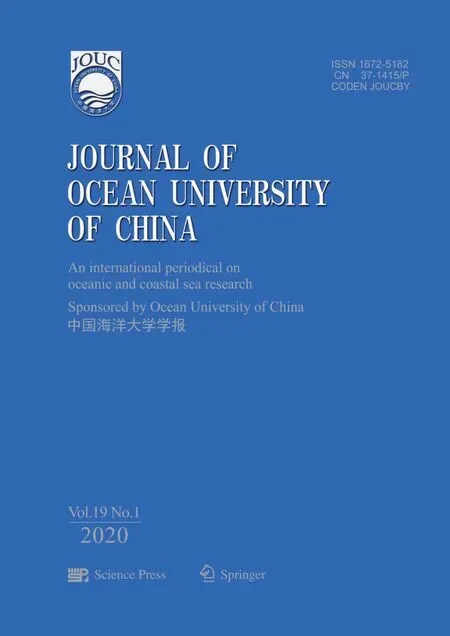 Journal of Ocean University of China2020年1期
Journal of Ocean University of China2020年1期
- Journal of Ocean University of China的其它文章
- Purification and Characterization of a Novel Lipase from Antarctic Krill
- Quality Assessment of Frozen Solenocera crassicornis Treated with Sodium Metabisulphite by Soaking or Spraying
- Contribution of Mesoscale Eddies to the Subduction and Transport of North Pacific Eastern Subtropical Mode Water
- Semi-Empirical Algorithm for Wind Speed Retrieval from Gaofen-3 Quad-Polarization Strip Mode SAR Data
- An Effective Method of Prompting Juvenile Rainbow Trout (Oncorhynchus mykiss) to Cope with Heat Stress
- Half Smooth Tongue Sole (Cynoglossus semilaevis) Under Low Salinity Stress Can Change Hepatic igf2 Expression Through DNA Methylation
